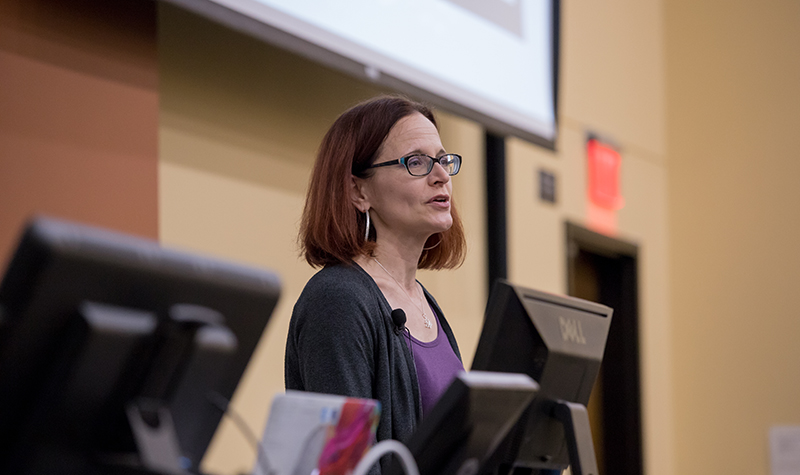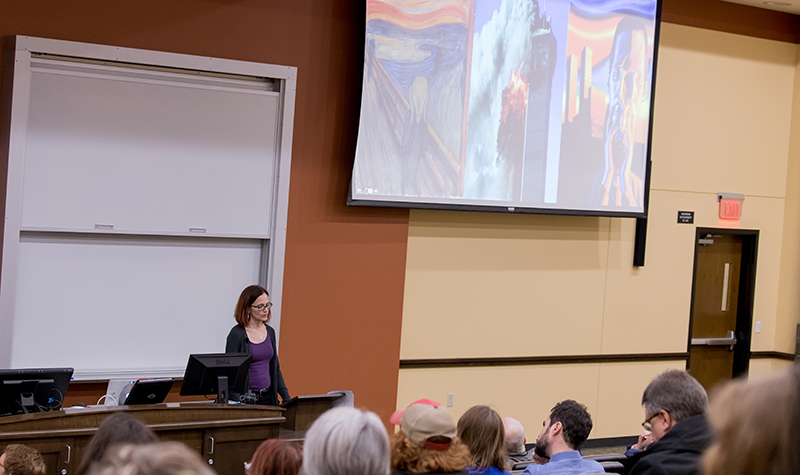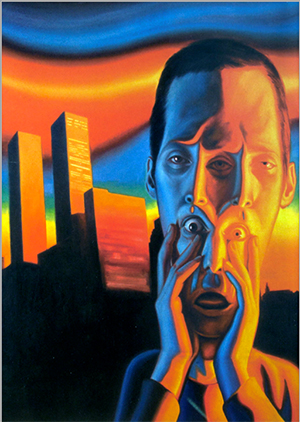08 Nov How art can further understanding of 9/11
In the second talk of the 2019-20 Faculty Lecture Series, UND Associate Professor Crystal Alberts described art’s role in deepening awareness of that terrible day

Art has enriched our understanding of previous conflicts such as World War II and the war in Vietnam, and it can do the same for our sense of the events of 9/11, said Crystal Alberts, associate professor of English at UND. Alberts made her remarks in the lecture she delivered Oct. 23 as part of the 2019-20 Faculty Lecture Series at UND. Photo by Connor Murphy/UND Today.
In the world of art museums, there’s a saying that “the basic condition for art appreciation is a chair.” Keep that in mind as you learn more about Crystal Alberts’ lecture, which she gave Oct. 23 as part of the 2019-20 Faculty Lecture Series at the University of North Dakota.
For in her talk, Alberts argued that even – or maybe especially – for events as vivid in memory as the 9/11 terrorist attacks, people should recognize that the media’s initial pictures and video form only the start of our understanding. They’re the first rough draft of history, as journalists call their trade.
And as our society has learned from conflicts such as the Civil War, World War II and the war in Vietnam, the second and third and fourth drafts arrive not only through historians’ work but also through art.
That’s happening with Sept. 11, Alberts noted. Many artists have offered and are offering their perspectives on 9/11 and what the terrorist attacks mean.
Moreover, and as Alberts showed, the artists’ work can offer a richer understanding to anyone willing to pause; to ponder, perhaps from the comfort of a chair; and to truly see.
Hence the title that Alberts chose for her talk: “‘I’m Only Just Starting to Look:’ Media, Art, and Literature after 9/11.”
Alberts, associate professor of English at UND and director of the UND Writers Conference, delivered the second in UND’s six-lecture 2019-20 Faculty Lecture Series. For UND faculty, the series plays two key roles, said Kim Donehower, academic director of composition and English Education Program coordinator at UND, who introduced Alberts.
“The first one, and I think the hardest because it takes so much preparation, is that the series asks faculty to translate their work for not just a general audience, but also an audience of people from different disciplinary backgrounds,” Donehower told UND Today.
“And the secondary purpose can stem from that, because, for example, with Crystal’s talk, some of her research describes how literature and art can help people understand traumatic events such as 9/11. So, a colleague in psychology or neurology or another department might learn about Crystal’s work and say, ‘Oh, here’s how that connects with something I’m working on.’”
Such cross-discipline connections are vital and tremendously exciting in academia, Donehower said. And because faculty spend so much time in their own departments and classrooms, “these lectures are really important for making those connections.”
‘Secondhand memories’
“Sept. 11, 2019, marked the 18th anniversary of the attacks,” Alberts said in her lecture.
“As such, many of our current students, and all future incoming freshmen entering college straight from high school, have or will have no direct memory of that day, because they were too young or weren’t alive yet.”
This means that for many of those students, including ROTC cadets, “the only knowledge that they have of the reasons for what is usually referred to as the ‘War on Terror’ are what (German writer and academic) W.G. Sebald has called ‘secondhand memories.’” These are the dramatic photos, videos and other news accounts of the day, plus the stories told by parents, teachers and other key figures in the students’ lives.
But just as novels, plays, sculpture and other art forms have enriched Americans’ understanding of the war in Vietnam, so, too, can art deepen our sense of what happened on 9/11, Alberts said.
That’s because “through imagination, the fine arts – painting, sculpture, literature – as well as more popular forms like comics transform the world around us,” Alberts said.
“Although art can be used as propaganda and can be exploitative, more often than not it enables us to see things from different points of view and in new ways, if we are willing and know how to look.”

As Crystal Alberts, associate professor of English, delivers her Faculty Lecture at UND on Oct. 23, the nearby screen shows a slide from Alberts’ PowerPoint presentation. On the slide are images (from left to right) of Edvard Munch’s painting “The Scream,” a news photo of the 9/11 attack on the World Trade Center and Ron English’s illustration for Issue 32 of World War 3 Illustrated, an underground comic. Photo by Connor Murphy/UND Today.
Art that pushes boundaries
But 9/11 poses a special challenge for artists, because the scale of the destruction and the horrific nature of so many of the deaths call for unusual sensitivity. To this day, even the media largely averts its eyes from the most terrifying video and photographic images, such as those of the people who jumped or fell from the Twin Towers.
Some artworks treat Sept. 11 solemnly and well. As examples, Alberts pointed to illustrator Art Spiegelman’s Sept. 24, 2011 cover of The New Yorker, which showed the black outlines of the Twin Towers against a black background; and the “Tribute in Light,” the searchlights near the World Trade Center site that create two vertical columns of light every Sept. 11 to commemorate the missing towers. The beams can be seen from up to 60 miles away.
Other artworks have sparked controversy, though, sometimes to the point where exhibitors quickly have removed the works from view, Alberts noted.
Then there are the works that strike a balance. They “push their audiences” beyond simple remembrance of the attacks, but do so without prurience or sensationalism, approaches that might push those audiences away.
Interestingly, some of the most powerful of these efforts have appeared in comics. That’s no accident: “The assumption that comics are primarily aimed at children has actually allowed comic artists greater freedom to push boundaries than they might otherwise have enjoyed,” Alberts said.

“Inside Front,” World War 3 Illustrated #32 by Ron English.
For example, consider Ron English’s illustration on the inside front cover of Issue 32 of World War 3 Illustrated, an underground political comic that has been published roughly twice a year since 1979.
Issue 32 came out in late 2001. And to capture his vision of the Sept. 11 attacks for the inside front cover of the issue, English harkened back to a 19th century artwork that has come to symbolize “anxiety, guilt, dread and the howling of the soul stripped bare,” noted Alberts: Edvard Munch’s The Scream.
“English merges the imagery of Munch’s iconic masterpiece with that of the pre-9/11 Manhattan skyline,” Alberts described.
“English echoes Munch’s color palette as well, using a similar combination of orange, yellow, blue and black,” she continued. These colors suggest the “flaming clouds and smoke that pierced the clear blue sky of New York on Sept. 11th.”
But English’s focus is less on the destruction than it is “on public reaction to the attacks,” Alberts noted. “He depicts a man’s face, mouth agape with his hands at his cheeks, staring out at the viewer. … The man’s head in the comic is composed of more than one face. It features five eyes – one for each of New York’s boroughs, each expressing a slightly different emotion – three noses but only one mouth, suggesting the multitudinous and yet somehow common perception of the event.”
With this panel, English “communicates the horrific, specific reality of 9/11,” Alberts said.
At the same time, English “also asks readers to connect their often-localized reactions … with those of others beyond the geographical boundaries of New York and the temporal moment of Sept. 11, 2001.
“The allusion to Munch turns the American gaze not only inward on its own national pain, but also outward to a human experience of pain that transcends historical or national boundaries,” Alberts noted.
Such is art’s power to enrich understanding beyond what a news photo or video typically can convey.
Letting art teach
The second example that Alberts highlighted – Baader-Meinhof, a short story by Don DeLillo that was first published in the The New Yorker in March of 2002 – also harkens back to an earlier work of art. That earlier work is Gerhard Richter’s portraits of the slain members of the Baader-Meinhof Group, the militant organization that terrorized Germany in the 1970s and 80s.
Those portraits now are part of the Museum of Modern Art’s permanent collection. They’re a challenging work, in part because they refuse to pass judgment on the terrorists’ ideology or actions.
And in a gesture that took political courage, coming as it did so soon after 9/11, the New York City-based MoMA put the portraits on display in 2002.
That show provides the setting for Baader-Meinhof‘s opening scene. In the scene, a woman sits in the MoMA gallery, where she has spent much of the past few days. She’s been transfixed by the portraits, especially by their blurriness, complexity and melancholy mood.
Then she’s approached by a man who can’t get beyond that blurriness. This makes him dismiss the artworks as he talks about them with the woman – while also trying to pick her up.
To use an old-fashioned term, the man is a cad. But a key to the story is “how the man starts to evolve through exposure to art and other points of view,” Alberts noted in her talk.
At the end of Baader-Meinhof, the man sits alone in the gallery, and gazes at the paintings almost as intently as the woman had in the opening scene. “He, too, seems to recognize that there is something more to see and understand,” Alberts said.
“He needs to study the paintings and let them teach him something.”
And that’s the key: Slow down, contemplate the artwork and imagery of 9/11, and strive in that study to see “the bigger picture of humanity,” Alberts said.
This is “ethical remembering,” as literary critic Viet Thanh Nguyen has described it, and it can lead to a fuller understanding of events. One way forward is through imagination, Alberts concluded, “often in the form of art like that of Munch, English, Richter or DeLillo. …
“However, art only has this transformative effect if we and future generations are willing to look.”


